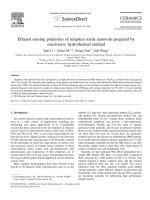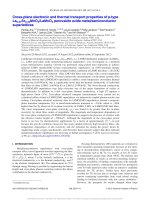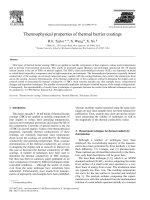Properties of concrete containing ground granulated blast furnace slag (GGBFS) at elevated temperatures
Bạn đang xem bản rút gọn của tài liệu. Xem và tải ngay bản đầy đủ của tài liệu tại đây (482.53 KB, 7 trang )
Journal of Advanced Research (2012) 3, 45–51
Cairo University
Journal of Advanced Research
ORIGINAL ARTICLE
Properties of concrete containing ground granulated
blast furnace slag (GGBFS) at elevated temperatures
Rafat Siddique *, Deepinder Kaur
Civil Engineering Department, Thapar University, Patiala, Punjab 147004, India
Received 21 July 2010; revised 16 December 2010; accepted 7 March 2011
Available online 16 April 2011
KEYWORDS
Concrete;
Ground granulated blast
furnace slag;
Temperature;
Strength;
Modulus of elasticity;
Mass loss
Abstract Normal strength (NSC) and high-performance concretes (HPC) are being used extensively in the construction of structures that might be subjected to elevated temperatures. The behaviour of concrete structures at elevated temperatures is of significant importance in predicting the
safety of structures in response to certain accidents or particular service conditions. This paper deals
with the mechanical properties of concrete made with ground granulated blast furnace slag
(GGBFS) subjected to temperatures up to 350 °C. For this purpose, normal concrete having compressive strength of 34 MPa was designed using GGBFS as partial replacement of cement. Cylindrical specimens (150 · 300 mm) were made and subjected to temperatures of 100, 200 and
350 °C. Measurements were taken for mass loss, compressive strength, splitting tensile strength,
and modulus of elasticity. This investigation developed some important data on the properties of
concrete exposed to elevated temperatures up to 350 °C.
ª 2011 Cairo University. Production and hosting by Elsevier B.V. All rights reserved.
Introduction
* Corresponding author. Tel.: +91 175 239 3027; fax: +91 175 239
3005.
E-mail address: (R. Siddique).
2090-1232 ª 2011 Cairo University. Production and hosting by
Elsevier B.V. All rights reserved.
Peer review under responsibility of Cairo University.
doi:10.1016/j.jare.2011.03.004
Production and hosting by Elsevier
The most important effects of elevated temperature on concrete are: dehydration of cement paste, porosity increase, modification in moisture content, thermal expansion, alteration of
pore pressure, strength loss, thermal cracking due to incompatibility, thermal creep and thermal spalling due to excessive
pore pressure [1,2]. Water distribution and transport, whether
in gaseous or liquid form, play important roles in the local
damage of concrete structures [3,4]. During heating, the endothermal nature of vaporisation creates locally high thermal
gradients and high vapour pressure, which can lead to tensile
stresses exceeding the concrete’s strength [5]. The escape of
chemically bounded water in the Calcium Silicate Hydrates
(CSH) leads to the failure of concrete at temperatures over
450 °C. Aggregate type strongly influences the behaviour of
46
concrete at elevated temperatures. The aggregate’s thermal
expansion is partly opposed to the drying of the cement paste.
This phenomenon makes it possible to think that limestone
aggregate, whose thermal coefficient of expansion is lower than
that of siliceous aggregate, is more favourable to the behaviour
of concrete at elevated temperatures [6]. Recent studies showed
a weak influence of the kinetics and durations of heat treatment on the residual properties of the concrete [3,4,7].
R. Siddique, D. Kaur
nal strength (lower w/cm) and with silica fume retained more
residual strength after elevated temperature exposure than
those with lower original strength (higher w/cm) and without
silica fume. Janotka and Nu¨rnbergerova´ [23] concluded that
the strength, elasticity modulus and deformation of concrete
were irreversibly influenced by temperature elevation, mainly
to 100 and 200 °C.
Research significance
Literature review
Elevated temperatures affect concrete’s microstructure,
strength properties, and permeability, and may result in loss
of strength and/or mass and increased porosity and/or
permeability.
The thermo-physical properties of concrete decreased with
the increase in temperature except for the specific heat, and
particularly the conductivity and the diffusivity are a 50%
lower at 900 °C as compared with the values at room temperature [8]. Castillo and Durrani [9] observed a loss of about
15–20% in strength at temperatures of 100–200 °C. Diederichs et al. reported that the residual strength of concrete
was below the initial strength at elevated temperatures [10].
According to Ghosh and Nasser [11], there was gradual deterioration of strength and static modulus of elasticity with a
rise in temperature (21–232 °C) at all pressures (5.2–
13.8 MPa). Felicetti and Gambarova [12] reported dramatic
reduction in residual compressive strength, splitting tensile
strength and elastic modulus at elevated temperatures up to
500 °C. Janotka and Ba´gel [13] revealed that there were no
significant changes at temperatures up to 400 °C. Noumowe
[14] concluded that after initial heating to 200 °C, and subsequent cooling, the residual compressive strength was 18–38%
lower than the non-heated concrete and PP fibres did not improve the initial compressive or the residual compressive
strength of the concrete.
There was significant reduction in the weight of the specimen and the relative strength of the concrete at elevated temperatures (200–1200 °C) [15]. There was no obvious explosive
spalling found in high-performance concrete (HPC) with blast
furnace slag (BFS) at temperatures of 20–800 °C [16]. Xiao and
Falkner [17] implied that BFS may contribute somewhat to the
residual compressive strength of HPCs at elevated temperatures. Xiao and Ko¨nig [18] mentioned that strength, elastic
modulus and peak strain, etc., degraded with increases in temperature, and the mechanical behaviour of concrete under high
temperature was better than that after high temperature.
Concretes containing slag as a partial replacement of cement (up to 40%) had higher compressive and flexural
strengths casting and curing at +42°C than those of concretes
made with Portland cement alone [19]. Wang and Chen [20]
observed that (i) the 7-day compressive strengths of mortars
with a water-to-cementitious material ratio of 0.44 were almost
proportional to the proportions of Portland cement; (ii) the
contribution of GGBFS to the strength gain over 7–28 days,
and also over 28–56 days, were the largest. Mahdy et al. [21]
observed that, as the temperature increased to 100 °C, the
strength of heavy weight high strength concrete decreased
compared to the room temperature strength. At the temperatures of 500 and 700 °C, the strength in each case dropped
sharply. Phan et al. [22] indicated that HPCs with higher origi-
Investigation of mechanical properties of concrete subjected to
elevated temperatures is very useful in the design of nuclear
structures. Type of cement and supplementary cementing
materials such as GGBFS play an important role in mechanical behaviour of concrete. Ground granulated blast furnace
slag (GGBFS) has become an important constituent material
for the design of normal strength and high-performance concrete. Existing literature does not provide the detailed investigation of the residual mechanical properties at high
temperatures of concrete made with GGBFS. The findings of
this investigation will help in predicting the behaviour of concrete made with GGBFS aggregates intended for nuclear or
similar applications.
Experimental
Materials
Ordinary Portland (53 grade) cement was used and its properties are given in Table 1. It met the requirements of Indian
Standard Specifications IS: 8112-1989 [24]. Natural sand with
a 4.75-mm maximum size was used as a fine aggregate. Coarse
aggregates used in this study were of 10 mm nominal size. They
were tested as per Indian Standard Specifications IS: 383-1970
[25] and their physical properties are given in Table 2. Ground
granulated blast furnace slag (GGBFS) was obtained from
Nippon Denro Ispat Ltd., India. Its properties are given in Table 3. Sikament 170, a concrete superplasticizer based on Sulphonated Naphthalene Polymer, was used as a water-reducing
admixture. The dosage of superplasticizer taken was 1.1% by
weight of cement.
Mixture proportions
One control mixture (M-0) was designed per Indian Standard
Specifications IS: 10262-1982 [26] to have 28-day compressive
Table 1
Properties of cement.
Physical test
Results
obtained
IS: 8112-1989
Specifications
Normal consistency (%)
Initial setting time (minutes)
Final setting time (minutes)
Fineness (%)
Specific gravity
34
48
240
3.0
3.10
–
>30
<600
<10
–
Compressive strength (MPa)
7-day
28-day
21.9
34.5
GGBFS Concrete at High Temperature
Table 2
47
Properties of aggregates.
Property
Fine aggregate
Coarse aggregate
Type
Maximum size (mm)
Specific gravity
Total water absorption (%)
Fineness modulus
Uncrushed
4.75
2.19
4.88
1.75
Crushed
10
2.6
2.32
6.17
correct dimensions before casting. Care was taken that there
were no gaps, so as to avoid the possibility of leakage from
the slurry. The specimens were allowed to remain in the steel
mould for the first 24 h at ambient conditions. They were then
demoulded with care so that no edges were broken and placed
in the curing tank at the ambient temperature. The ambient
temperature for curing was 27 ± 2 °C.
Heating and cooling regimes
strength of 34.8 MPa. The other concrete mixtures, viz. M-1 to
M-3, were made with replacement levels of 20%, 40%, and
60% of GGBFS by weight of cement. In doing so, the
water-to-cementitious materials ratio was kept the same in order to investigate the effects of replacing cement with GGBFS
when other parameters were unchanged. The mixture, designation and quantities of the various materials for each designed
concrete mixture are given in Table 4.
After curing for 28 and 56 days, the specimens were taken out
of the tank and air-dried. Then the specimens were heated in
an electric oven up to 100, 200, and 350 °C. The heating rate
was set at 8 °C/min. The temperature was maintained at the
respective temperature for 1 h to achieve a thermally steady
state. Then the furnace door was opened and the specimens
were allowed to cool naturally to room temperature.
Testing procedures
Preparation and casting of specimens
Cylindrical moulds of size 150 · 300 mm were used to prepare
the concrete specimens for the determination of compressive
strength, splitting tensile strength and modulus of elasticity
of concrete. All specimens were prepared in accordance with
Indian Standard Specifications IS: 516-1959 [27]. Moulds were
cleaned and oiled properly. They were securely tightened to
Table 3
Properties of GGBFS.
Concrete cylinders, 150 · 300 mm, were tested for the determinations of compressive strength, split tensile strength and modulus of elasticity of concrete as per Indian Standard
Specifications IS: 516-1959 [27] in a fully computerised servocontrolled universal testing machine of maximum compression
capacity 1000 KN. A uniaxial compressive load was applied at
a rate of 0.5 MPa/s or with a load speed of 235.62 KN/min, in
the direction of the central axis of the specimen.
Results and discussion
Properties
GGBFS
Specification
Requirements
as per BS: 6699
Fineness (m2/kg)
Soundness Le-Chatelier
expansion (mm)
Insoluble residue (%)
Magnesia content (%)
Sulfide sulfur (%)
Sulfite content (%)
Loss on Ignition (%)
Manganese content (%)
Chloride content
Moisture content
Glass content (%)
340
1.5
275 (min.)
10.0 (max.)
1.5
12.0
1.7
2.5
1.0
1.0
0.05
1.0
90
1.5 (max.)
14.0 (max.)
2.00 (max.)
2.50 (max.)
3.00 (max.)
2.00 (max.)
0.10 (max.)
1.0 (max.)
67 (min.)
Compressive strength (MPa)
7 days
28 days
0
20
40
60
25
40
12.0 (min.)
32.5 (min.)
28
Chemical moduli
(a) CaO+MgO+SiO2
(b) CaO+MgO/SiO2
(c) CaO/SiO2
100 °C
200 °C
350 °C
0.5
1.5
3.0
1.0
2.5
3.0
1.5
3.0
4.0
2.5
3.0
5.0
70
>1.0
<1.4
66.66 (min.)
>1.0
<1.4
56
100 °C
200 °C
350 °C
0.5
1.5
2.5
1.5
2.5
3.0
1.5
3.0
4.5
2.5
4.0
6.0
Mass loss
Mass loss measurements were recorded between 27 and
350 °C, and the results are given in Table 5. Mass loss increased with the increase in temperature. Below 100 °C, generally little mass loss is observed, since abundant free water is
not left in the hardened and dried concrete specimens. When
temperature is raised from 100 to 350 °C, the mass loss is little
Table 5
Mass loss of GGBFS concrete.
Testing age (days) Temperature exposure GGBFS content (%)
Table 4
Mixture proportions.
Mixture
Cement (kg/m3)
GGBFS (kg/m3)
Fine agg. (kg/m3)
Course agg. (kg/m3)
Water (l/m3)
Plasticizer (l/m3)
Slump (mm)
M-0
M-1
M-2
M-3
450
360
270
180
0
90
180
270
482
482
482
482
1040
1040
1040
1040
203
203
203
203
4.95
4.95
4.95
4.95
100
90
85
75
48
R. Siddique, D. Kaur
Compressive strength
him [19] reported 14.9%, 17.0% and 42.5% loss in 28-day
compressive strength as compared to the control (47 MPa) at
10%, 20% and 40% GGBFS contents, respectively. A similar
trend was also observed by Dehuai and Zhaoyuan [20] wherein
they reported 21.2%, 25.8% and 36% loss in 28-day compressive strength as compared to the strength of the control
(51.9 MPa) at 35%, 50% and 70% GGBFS content, respectively. But at 100 and 200 °C and at both the ages, the compressive strength increased at 20% GGBFS content and then
decreased afterwards.
Compressive strength test results are shown in Figs. 1 and 2.
Effect of temperature on 28-day compressive strength
Effect of replacement of cement with GGBFS
Fig. 1 shows that at 28-days, with 0% GGBFS, the residual
compressive strength of concrete at 100 °C dropped by
28.6% as compared to room temperature strength
(34.8 MPa). The reduction could be due to the stresses generated at the interface between the aggregate and the hardened
cement paste on heating. The difference between the thermal
expansion of the cement paste and the aggregate could result
in micro-cracking and disruption of the cement-aggregate
bond with a consequent reduction in strength. As the temperature increased beyond 100 °C, the compressive strength increased a little but was still lower than that of room
temperature strength and it increased further, by 12.6%, at
350 °C. This increase was considered to be mainly due to rapid
drying of the concrete, which increased its strength. Xiao and
Ko¨nig [18], Mahdy et al. [21] and Phan et al. [22] reported similar findings. Xiao and Ko¨nig [18] had explained in one graph
this trend through the work of four researchers (Li and Guo
[28]; Lu [29]; Niu et al. [30]; and Yao [31]), each showing the
same type of trend, i.e. decrease in strength at 100 °C, then
some increase at 200 °C and further increase at 300 °C.
According to Mahdy’s [21] investigations, the compressive
strength decreased at 100 °C by 28% as compared to room
temperature strength (99.72 MPa). With a further increase in
temperature to 300 °C, the specimens recovered the strength
loss and reached peak strength of 18% above room temperature strength.
A similar trend was observed with 20% replacement of cement by GGBFS at 28-days, i.e. a decrease in compressive
strength by 11.8% at 100°C and then an increase by 8% at
200°C and another increase, by 15.6%, at 350°C, as compared
to room temperature strength (28.9 MPa). But at 40% and
60% replacements of cement with GGBFS at 28-days, the relative residual compressive strength did not change significantly
with rises in temperature, and thus maintained their original
compressive strengths. This implies that GGBFS may contribute to some extent to the residual compressive strength of concrete at elevated temperatures. Similar findings were reported
by Xiao and Falkner [17]. Therefore, from these investigations
we can conclude that at 20% GGBFS content, the rate of
strength loss of concrete is less as compared to the concrete
containing no GGBFS and at 40% and 60% GGBFS content
there is no strength loss.
more owing to the release of both capillary water and gel
water. When the heating is continued beyond 200 °C, then a
portion of water in hydrated products escapes. It was noticed
that the water loss for the specimens heated at 100 °C was
three times lower than that measured in the specimens heated
at 200 and 350 °C. This confirms the small proportion of free
water in this concrete compared to the hydrated concrete’s
water content.
It is evident from these results that the compressive strength of
concrete mixtures decreased with the increase in GGBFS content at normal temperature (27 °C) and 350 °C. At room temperature (27 °C), 28-day compressive strength of concrete
containing 20%, 40% and 60% GGBFS was respectively
16.8%, 23.9% and 28.5% lower than the control mixture
(34.8 MPa). Similar findings were reported by Ujhelyi and
Ibrahim [19] and Dehuai and Zhaoyuan [20]. Ujhelyi and Ibra50
0% GGBS
Compressive Strength (MPa)
45
20% GGBS
40% GGBS
40
60% GGBS
35
30
25
20
15
0
100
200
Temperature (degree)
300
400
Fig. 1 Effect of temperature on the compressive strength of
concrete at the age of 28 days.
50
0% GGBS
Compressive Strength (MPa)
45
20% GGBS
40% GGBS
40
60% GGBS
35
30
25
20
15
Effect of temperature on 56-day compressive strength
0
100
200
300
Temperature (degree)
400
Fig. 2 Effect of temperature on the compressive strength of
concrete at the age of 56 days.
Fig. 2 shows that at 56-days, the residual compressive strength
decreased with the increase in temperature at all percentages of
GGBFS. At 0% replacement, the residual compressive
GGBFS Concrete at High Temperature
49
strength decreased by 21.9%, 29.9% and 16% at 100, 200 and
350 °C, respectively when compared to normal temperature
strength (39.8 MPa). Similarly, the residual compressive
strength decreased at all other percentages of GGBFS with increases in temperature. But the decrease was comparatively
less than in the concrete containing no GGBFS. Degradation
of mechanical properties of this concrete between room temperature and 100 °C was very limited. But at 200 and 350 °C,
there was a significant reduction in compressive strength, ranging between 16–30% at 20%, 40% and 60% replacement of cement by GGBFS. This is probably because when the
temperature was raised to 200 and 350 °C, the water loss was
very significant. The modification of hydrates generated a degradation of the concrete microstructure.
Splitting tensile strength
Splitting tensile strength test results are shown in Figs. 3 and 4.
Effect of replacement of cement with GGBFS
with increases in GGBFS content. The splitting tensile strength
of concrete containing 20%, 40% and 60% GGBFS was
respectively 17.4%, 8.2%, and 15.6% lower than the control
(3.2 MPa) at room temperature.
Effect of temperature on splitting tensile strength
The splitting tensile strength of concrete decreased with the increase in temperature (Figs. 3 and 4). At 28 days (Fig. 3), the
splitting tensile strength of concrete containing 20% GGBFS
content at 100, 200 and 350 °C was respectively 17.68%,
21.0%, and 28.9% lower than the concrete at room temperature (2.94 MPa). Similar trends were observed with concrete
containing 40% and 60% GGBFS. It is evident from Fig. 4
that a similar trend was found at 56 days. The loss in split tensile strength is very pronounced, which is different from the
more gradual loss of compressive strength. This is because
the tensile strength is more sensitive to cracks either on a
macro- or micro-scale, which are caused by concrete becoming
subject to high temperatures.
It is evident from these results that the 28-day splitting tensile
strength of concrete at room temperature (27 °C) decreased
20
16
0% GGBS
20% GGBS
40% GGBS
3.5
Modulus of Elasticity (GPa)
Splitting tensile strength (MPa)
4
3
2.5
2
1.5
1
100
200
Temperature (degree)
300
0
100
200
300
Temperature (degree)
400
20
0% GGBS
20% GGBS
40% GGBS
60% GGBS
0% GGBS
4
20% GGBS
Modulus of Elasticity (GPa)
Splitting Tensile Strength (MPa)
4
Fig. 5 Effect of temperature on the modulus of elasticity of
concrete at the age of 28 days.
4.5
40% GGBS
3.5
60% GGBS
3
2.5
2
1.5
1
60% GGBS
8
400
Fig. 3 Effect of temperature on the splitting tensile strength of
concrete at the age of 28 days.
20% GGBS
40% GGBS
12
0
0
0% GGBS
0
100
200
Temperature (degree)
300
400
Fig. 4 Effect of temperature on the splitting tensile strength of
concrete at the age of 56 days.
16
12
8
4
0
0
100
200
Temperature (degree)
300
400
Fig. 6 Effect of temperature on the modulus of elasticity of
concrete at the age of 56 days.
50
Modulus of elasticity
In this investigation, the modulus of elasticity, which is also
called the secant modulus, is taken as the slope of the chord
from the origin to some arbitrary point on the stress–strain
curve. The secant modulus calculated in this study is at 33%
of the maximum stress. The modulus of elasticity of concrete
mixtures was determined at the ages of 28 and 56 days. The results are shown in Figs. 5 and 6.
Effect of replacement of cement with GGBFS
It is evident from these results that the 28-day modulus of elasticity of concrete at room temperature (27 °C) decreased with
increases in GGBFS content. The modulus of elasticity of concrete containing 20%, 40% and 60% GGBFS was respectively
22.5%, 39.98% and 41.7% lower than the control (15.98 GPa)
at room temperature.
Effect of temperature on modulus of elasticity
Fig. 5 shows the variation of modulus of elasticity with temperature at 28-days. The modulus of elasticity of concrete decreased with increases in temperature. At 0% GGBFS content,
the modulus of elasticity of concrete at 100, 200 and 350 °C
was respectively 24.1%, 24.6% and 32.5% lower than the control (15.98 GPa). Similar tends were observed with concrete
made with 20%, 40%, and 60% GGBFS.
Fig. 6 shows the variation of modulus of elasticity with temperature at 56 days. The modulus of elasticity of concrete decreased with increases in temperature at 56 days at all
percentages of GGBFS content. At 0% GGBFS content, the
modulus of elasticity of concrete at 100, 200 and 350 °C was
respectively 13.1%, 23.4% and 37.5% lower than the control
(16.32 GPa). At 20% GGBFS content, the modulus of elasticity of concrete at 100, 200 and 350 °C was respectively 20.13%,
41.2% and 47.6% lower than the concrete at room temperature (14.11 GPa). At 40% GGBFS content, the modulus of
elasticity of concrete at 100, 200 and 350 °C was respectively
12.5%, 23.9% and 38.7% lower than the concrete at room
temperature (10.51 GPa), and at 60% GGBFS content, the
modulus of elasticity of concrete at 100, 200 and 350 °C was
respectively 12.7%, 21.4% and 35.7% lower than the concrete
at room temperature (9.95 GPa).
Conclusions
Based on the results obtained, the following conclusions can be
drawn:
Concrete containing GGBFS could possibly be used in
applications involving elevated temperatures. There was no
very significant deterioration of the mechanical properties of
the concrete between 27 and 100 °C. Reduction in the values
of compressive strength, splitting tensile strength and modulus
of elasticity remained lower than 40% of the initial value even
after a temperature of 350 °C was applied. At temperatures between 200 and 350 °C, the mass loss is not very significant. The
modification of the hydrates generates a degradation of the
concrete microstructure. From the results it can be easily concluded that up to 20% GGBFS could be suitably used in con-
R. Siddique, D. Kaur
crete designed for nuclear structures. However, more
investigations are needed on other parameters such as thermal
behaviour, porosity, and permeability aspects. These results
could be useful in further investigating the behaviour of concrete made with GGBFS at elevated temperatures.
References
[1] Bazant ZP, Kaplan MF. Concrete at high temperature: material
properties and mathematical models. Longman; 1996.
[2] Ulm FJ, Coussy O, Bazˇant ZP. The ‘‘chunnel’’ fire. I:
Chemoplastic softening in rapidly heated concrete. J Eng
Mech 1999;125(3):272–81.
[3] Galle C, Sercombe J, Pin M, Arcier G, Bouniol P. Behaviour of
high performance concrete under high temperature (60–450 °C)
for surface long-term storage: thermo-hydro-mechanical
residual properties. In: Proceedings of the MRS Conference
Sydney, Australia. 2000.
[4] Noumowe A, Debicki G. Effect of elevated temperature from
200 to 600 °C on the permeability of high performance concrete.
In: Proceedings of the 6th international symposium on
utilization of high strength/performance concrete, vol. 1,
Leipzig, Germany. 2002.
[5] Noumowe AN, Clastres P, Debicki G, Costaz JL. Transient
heating effect on high strength concrete. Nucl Eng Des
1996;166(1):99–108.
(6) Bouniol P. Be´tons spe´ciaux de protection. Tech.l’Inge´nieur 2001
Avril; BN: BN3740.
[7] Noumowe A, Galle C. Study of high strength concrete at raised
temperature up to 200 °C: thermal gradient and mechanical
behaviour. In: Proceedings of the 16th structural mechanics in
reactor technology, Washington, DC, USA. 2001.
[8] Shin KY, Kim SB, Kim JH, Chung M, Jung PS. Thermophysical properties and transient heat transfer of concrete at
elevated temperatures. Nucl Eng Des 2002;212(1-3):233–41.
[9] Castillo C, Durrani AJ. Effect of transient high temperature on
high-strength concrete. ACI Mater J 1990;87(1):47–53.
[10] Diederichs U, Jumppanen UM, Penttala V. Behavior of high
strength concrete at high temperatures. Rep. No. 92. Finland:
Helsinki University of Technology. 1989.
[11] Ghosh S, Nasser KW. Effects of high temperature and pressure
on strength and elasticity of lignite fly ash and silica fume
concrete. ACI Mater J 1996;93(1):51–60.
[12] Felicetti R, Gambarova PG. Effects of high temperature on the
residual compressive strength of high-strength siliceous
concretes. ACI Mater J 1998;95(4):395–406.
[13] Janotka I, Ba´gel L. Pore structures, permeabilities and
compressive strengths of concrete at temperatures up to
800 °C. ACI Mater J 2003;100(1):87–9.
[14] Noumowe´ AN. Temperature distribution and mechanical
properties of high-strength silica fume concrete at
temperatures up to 200 °C. ACI Mater J 2003;100(4):326–30.
[15] Arioz O. Effects of elevated temperatures on properties of
concrete. Fire Saf J 2007;42(8):516–22.
[16] Xiao J, Xie M, Zhang C. Residual compressive behaviour of
pre-heated high-performance concrete with blast-furnace-slag.
Fire Saf J 2006;41(2):91–8.
[17] Xiao J, Falkner H. On residual strength of high-performance
concrete with and without polypropylene fibres at elevated
temperatures. Fire Saf J 2006;41(2):115–22.
[18] Xiao J, Ko¨nig G. Study on concrete at high temperature in
China – an overview. Fire Saf J 2004;39(1):89–103.
[19] Ujhelyi JE, Ibrahim AJ. Hot weather concreting with hydraulic
additives. Cem Concr Res 1991;21(2-3):345–54.
[20] Wang D, Chen Z. On predicting compressive strengths of
mortars with ternary blends of cement, GGBFS and fly ash.
Cem Concr Res 1997;27(4):487–93.
GGBFS Concrete at High Temperature
[21] Mahdy M, Speare PRS, Abdel Reheem AH. Effect of transient
high temperature on heavyweight, high strength concrete. New
York, NY: Columbia University; 2002.
[22] Phan LT, Lawson JR, Davis FL. Effects of elevated temperature
exposure on heating characteristics, spalling and residual
properties of high performance concrete. Mater Struct
2001;34(236):83–91.
[23] Janotka I, Nu¨rnbergerova´ T. Effect of temperature on structural
quality of high-strength concrete with silica fum. In: Transactions
of the 17 th international conference on structural mechanics in
reactor technology (SMiRT 17), Prague, Czech Republic. 2003.
[24] Anonymous Specifications for 53-grade Portland cement.1989IS:
8112. Bureau of Indian Standards, New Delhi, India.
[25] Anonymous Specifications for coarse and fine aggregates from
natural sources for concrete. IS: 383. Bureau of Indian
Standards, New Delhi, India. 1970.
51
[26] Anonymous Recommended guidelines for concrete mix design.
IS: 10262. Bureau of Indian Standards, New Delhi, India. 1982.
[27] Anonymous Indian standard code of practice-methods of test
for strength of concrete. IS: 516. Bureau of Indian Standards,
New Delhi, India. 1959.
[28] Li W, Guo Z. Experimental investigation on strength and
deformation of concrete under high temperature. J Build Struct
1993;14(1):8–16.
[29] Lu ZD. A research on fire response of reinforced concrete
beams. Tongji University; 1989.
[30] Niu H, Ma YF, Yao YX. Fire-resistance research on lightweight
aggregate elements. Chin Build Struct 1996;26(7):29–33.
[31] Yao YX. Research on fire response of reinforced concrete
frames and determination of temperature reached during a
fire. Tongji University; 1991.









